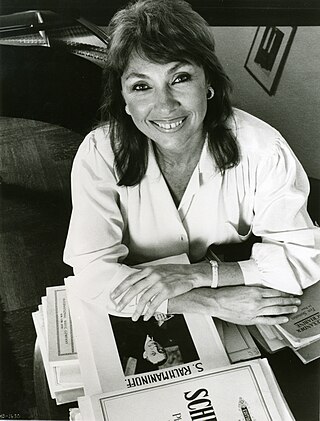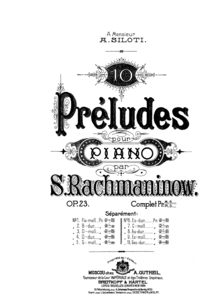
Sergei Vasilyevich Rachmaninoff was a Russian composer, virtuoso pianist, and conductor. Rachmaninoff is widely considered one of the finest pianists of his day and, as a composer, one of the last great representatives of Romanticism in Russian classical music. Early influences of Tchaikovsky, Rimsky-Korsakov, and other Russian composers gave way to a thoroughly personal idiom notable for its song-like melodicism, expressiveness, dense contrapuntal textures, and rich orchestral colours. The piano is featured prominently in Rachmaninoff's compositional output and he used his skills as a performer to fully explore the expressive and technical possibilities of the instrument.

The Rhapsody on a Theme of Paganini, Op. 43, is a concertante work written by Sergei Rachmaninoff for piano and orchestra, closely resembling a piano concerto, all in a single movement. Rachmaninoff wrote the work at his summer home, the Villa Senar in Switzerland, according to the score, from 3 July to 18 August 1934. Rachmaninoff himself, a noted performer of his own works, played the piano part at the piece's premiere on 7 November 1934, at the Lyric Opera House in Baltimore, Maryland, with the Philadelphia Orchestra conducted by Leopold Stokowski.

Nikolai Karlovich Medtner was a Russian composer and virtuoso pianist. After a period of comparative obscurity in the 25 years immediately after his death, he is now becoming recognized as one of the most significant Russian composers for the piano.

The Piano Concerto No. 2 in C minor, Op. 18, is a concerto for piano and orchestra composed by Sergei Rachmaninoff between June 1900 and April 1901. The piece established his fame as a concerto composer and is one of his most enduringly popular pieces.

Six moments musicaux, Op. 16, is a set of solo piano pieces composed by the Russian composer Sergei Rachmaninoff between October and December 1896. Each Moment musical reproduces a musical form characteristic of a previous musical era. The forms that appear in Rachmaninoff's incarnation are the nocturne, song without words, barcarolle, virtuoso étude, and theme and variations.
Sergei Rachmaninoff's Trio élégiaque No. 2 in D minor, Op. 9 is a piano trio which he began composing on 25 October 1893 and completed on 15 December that year. It was written in memory of Tchaikovsky, and was inscribed with the dedication "In Memory of a Great Artist". It was first performed in Moscow on 31 January 1894 by Rachmaninoff himself, the violinist Julius Conus, and the cellist Anatoli Brandukov.
Sergei Rachmaninoff's Prelude in C-sharp minor, Op. 3, No. 2, is one of the composer's most famous compositions. Part of a set of five piano pieces titled Morceaux de fantaisie, it is a 62-bar prelude in ternary (ABA) form. It is also known as The Bells of Moscow since the introduction seems to reproduce the Kremlin's most solemn carillon chimes.

Ruth Laredo was an American classical pianist.

Piano Concerto No. 4 in G minor, Op. 40, is a major work by Russian composer Sergei Rachmaninoff, completed in 1926. The work exists in three versions. Following its unsuccessful premiere, the composer made cuts and other amendments before publishing it in 1928. With continued lack of success, he withdrew the work, eventually revising and republishing it in 1941. The original manuscript version was released in 2000 by the Rachmaninoff Estate to be published and recorded. The work is dedicated to Nikolai Medtner, who in turn dedicated his Second Piano Concerto to Rachmaninoff the following year.
Suite No. 1 in G minor, Op. 5, is a suite for two pianos written by Sergei Rachmaninoff. The suite was a musical depiction of four poems written in the summer of 1893 at the Lysikof estate in Lebeden, Kharkov. The premiere took place in Moscow, on November 30, 1893, played by Rachmaninoff himself alongside Pavel Pabst. The work was dedicated to Tchaikovsky, who intended to attend the work's premiere, but died five weeks prior. Its four movements alongside their respective poems are as follows:
Sergei Rachmaninoff composed his Symphony No. 3 in A minor, Op. 44 between 1935 and 1936. The Third Symphony is considered a transitional work in Rachmaninoff's output. In melodic outline and rhythm it is his most expressively Russian symphony, particularly in the dance rhythms of the finale. What was groundbreaking in this symphony was its greater economy of utterance compared to its two predecessors. This sparer style, first apparent in the Rhapsody on a Theme of Paganini, enhances the emotional power of the work.
Arseny Nikolayevich Koreshchenko was a pianist and composer of classical music, including operas and ballets. He was from the Russian Empire.
Variations on a Theme of Corelli, Op. 42, is a set of variations for solo piano, written in 1931 by the Russian composer Sergei Rachmaninoff. He composed the variations at his holiday home in Switzerland.

Thirteen Preludes, Op. 32, is a set of thirteen preludes for solo piano, composed by Sergei Rachmaninoff in 1910.

Piano Sonata No. 1 in D minor, Op. 28, is a piano sonata by Sergei Rachmaninoff, completed in 1908. It is the first of three "Dresden pieces", along with the Symphony No. 2 and part of an opera, which were composed in the quiet city of Dresden, Germany. It was originally inspired by Goethe's tragic play Faust; although Rachmaninoff abandoned the idea soon after beginning composition, traces of this influence can still be found. After numerous revisions and substantial cuts made at the advice of his colleagues, he completed it on April 11, 1908. Konstantin Igumnov gave the premiere in Moscow on October 17, 1908. It received a lukewarm response there, and remains one of the least performed of Rachmaninoff's works.

The composer Sergei Rachmaninoff produced a number of solo piano pieces that were either lost, unpublished, or not assigned an opus number. While often disregarded in the concert repertoire, they are nevertheless part of his oeuvre. Sixteen of these pieces are extant; all others are lost. Ten of these pieces were composed before he completed his Piano Concerto No. 1, his first opus, and the rest interspersed throughout his later life. In these casual works, he draws upon the influence of other composers, including Frédéric Chopin and Pyotr Tchaikovsky. The more substantial works, the Three Nocturnes and Four Pieces, are sets of well-thought out pieces that are his first attempts at cohesive structure among multiple pieces. Oriental Sketch and Prelude in D minor, two pieces he composed very late in his life, are short works that exemplify his style as a mature composer. Whether completed as a child or adult, these pieces cover a wide spectrum of forms while maintaining his characteristic Russian style.

Caprice bohémien, Op. 12, also known as the "Capriccio on Gypsy Themes", is a symphonic poem for orchestra composed by Sergei Rachmaninoff from 1892 to 1894.

Russian Rhapsody is a piece for two pianos in E minor composed by Sergei Rachmaninoff in 1891, when he was 18 years old. It is more accurately described as a set of variations on a theme, rather than a true rhapsody. It was premièred on October 29, 1891, and its performance lasts approximately nine minutes.
The Études-Tableaux, Op. 33, is the first of two sets of piano études composed by Sergei Rachmaninoff. They were intended to be "picture pieces", essentially "musical evocations of external visual stimuli". But Rachmaninoff did not disclose what inspired each one, stating: "I do not believe in the artist that discloses too much of his images. Let [the listener] paint for themselves what it most suggests." However, he willingly shared sources for a few of these études with the Italian composer Ottorino Respighi when Respighi orchestrated them in 1930.




















